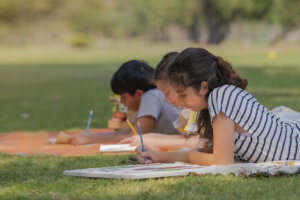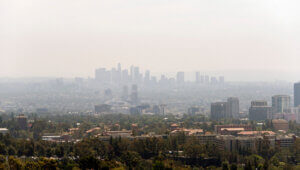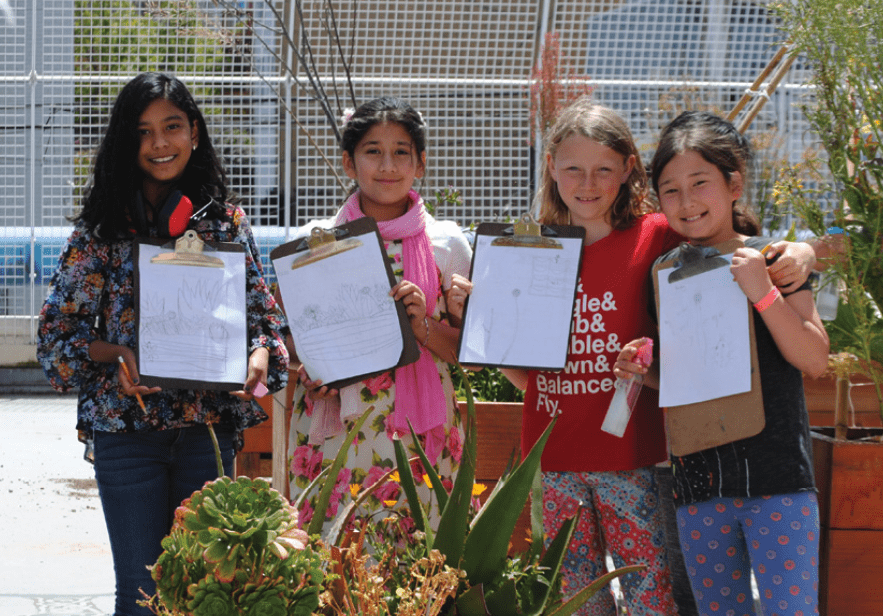Science gives us critical clues to understanding the complex web of the natural world, how it works, and how we can embrace our role in it. Dr. Suzanne Pierre, a member of CAELI’s leadership council and environmental science educator at San Francisco’s Exploratorium Teacher Institute, believes this kind of curiosity and connection are the basis for understanding and action. That’s why Sue leverages her perspective as a microbial ecology researcher and woman of color as she supports teachers to incorporate hands-on, inquiry-rich experiences into their classrooms. By uplifting environmental literacy centered around social justice, she’s helping to lead the movement to provide more hands-on, relevant, and racially equitable environmental education opportunities for K–12 students and their classroom teachers.
We met with Sue to learn more about how she’s formed a connection between research and education, driven by her strong belief in knowledge as power. In this Q&A, she shares how social justice practices inform her work as an environmental science educator, and why high-quality science education could be the key to building a more just and sustainable world.
Please share some of your background in ecology and biochemistry. How does that inform the work you do for the Exploratorium and the Critical Ecology Lab?

As an undergraduate, I was planning on going into journalism and didn’t expect to be in the STEM field at all. What made me pursue STEM was this idea that there are certain tools in the sciences that are like an entry point to having power. This access to power means being able to measure the world around you. As a woman of color, it felt like this challenge to take on the hard sciences when I wasn’t really inclined that way at first. So I ended up doing my undergraduate and grad school work in the environmental sciences. I’ve continued that same line of thinking, that there’s something really invaluable about becoming an expert. We can challenge the unequal distribution of power by being able to use empirical tools, which are used by those in power to control those who do not have those tools.
I wanted to share that knowledge in a way that’s not an echo chamber, as academic spaces can sometimes feel. The public needs somebody who cares about them deeply to share that, so I moved toward education. I think of myself as a public servant.
I came into my position at the Exploratorium right before the pandemic started. I was given this broad mandate to think about what’s important in environmental science right now and how that can be translated into the teacher professional development space. I think environmental science in most K–12 textbooks is presented really differently than the way present-day scientists see their work, in terms of framing.
I want to help relay a holistic and interdependent sense of how the environment is responding to anthropogenic processes. So my whole thing is to start connecting global change at different scales in the classroom, starting in the professional development space and moving into the actual classroom, or now, virtual classroom.
In what ways does your background in science and research inform your teacher training practices?
My approach with teachers is to not just give them the opportunity to explore one or two phenomena, but also to make this map in their minds of the relationships between what’s often taught as individual chunks of ideas about the environment. For example, one of the first workshops I taught for new teachers was about plant functions and how they are related to global processes.
My science background has helped me to see what people have a hard time relating to, then do my best to guide them through those steps. How do we go from thinking about taking a walk in your neighborhood, to looking at different shapes of leaves, to making inferences about how those leaf shapes relate to the climate that plant came from? I’m focused on thinking about the ways that can logically and comfortably fit together, then create this bigger picture.
You talked about reaching into communities that have been historically marginalized from access to nature. How do you think education plays a role in bridging that divide?
Communities have been marginalized from nature, in the space of the city but also in suburbs. Physical proximity to nature isn’t always the determining factor of access or involvement. It’s actually a sense of welcomeness and involvement and agency. That’s where I think education has to be this intervention point.
If society is telling a group of people “you don’t belong here,” or generalizing them as not caring about or understanding concepts around nature, they’re going to believe them until there’s a counter narrative, which implicates that community in nature in a way that’s real and relevant and also scientific. Educators can provide that counter narrative.
Where do you think the field of environmental education is heading?
I think environmental literacy is becoming a bit more aware of the ways that it has historically put the social dimensions as an addendum at the end of chapter. Whereas now, I think there’s an awareness that the social dimensions need to be woven throughout everything we talk about, and that we’re not just saying how humans have affected the environment, but having that conversation about the reciprocal relationship between what society does and then what happens to society in turn.
And now, because of the pandemic and other factors, it’s becoming clear that physical interaction with nature and opportunities to be outside are game-changing. These things are part of the equity question, too, because there’s now data that shows that students from backgrounds historically marginalized in the environment can have completely different learning outcomes, on a quantitative level, through a guided experience in nature. It shows that the more we allow the outdoor space to be racialized, the more difficult it’s going to be to push forward what we’re calling environmental literacy.
How does that broader framing of “global change” integrate into building a sustainable society?
As far as I’ve seen, sustainability has been such a contentious term and concept because it’s so often taught on the level of the individual footprint. Our individual carbon footprints are real. But this framing is problematic because it absolves the real perpetrators of the global change issues we’re seeing. Yes, we should build a sustainable society. But our unsustainable society was not built by individuals. That’s the reality.
Global change is useful because it allows us to scale up and down. When we think about global change on that global scale, you can see that no individual or set of individuals could possibly have motivated the scale of change we have seen. Global change is a way of reminding us that there are so many huge and invisible players in this. We cannot address our local sustainability issues or global sustainability issues without addressing these systemic forces.







